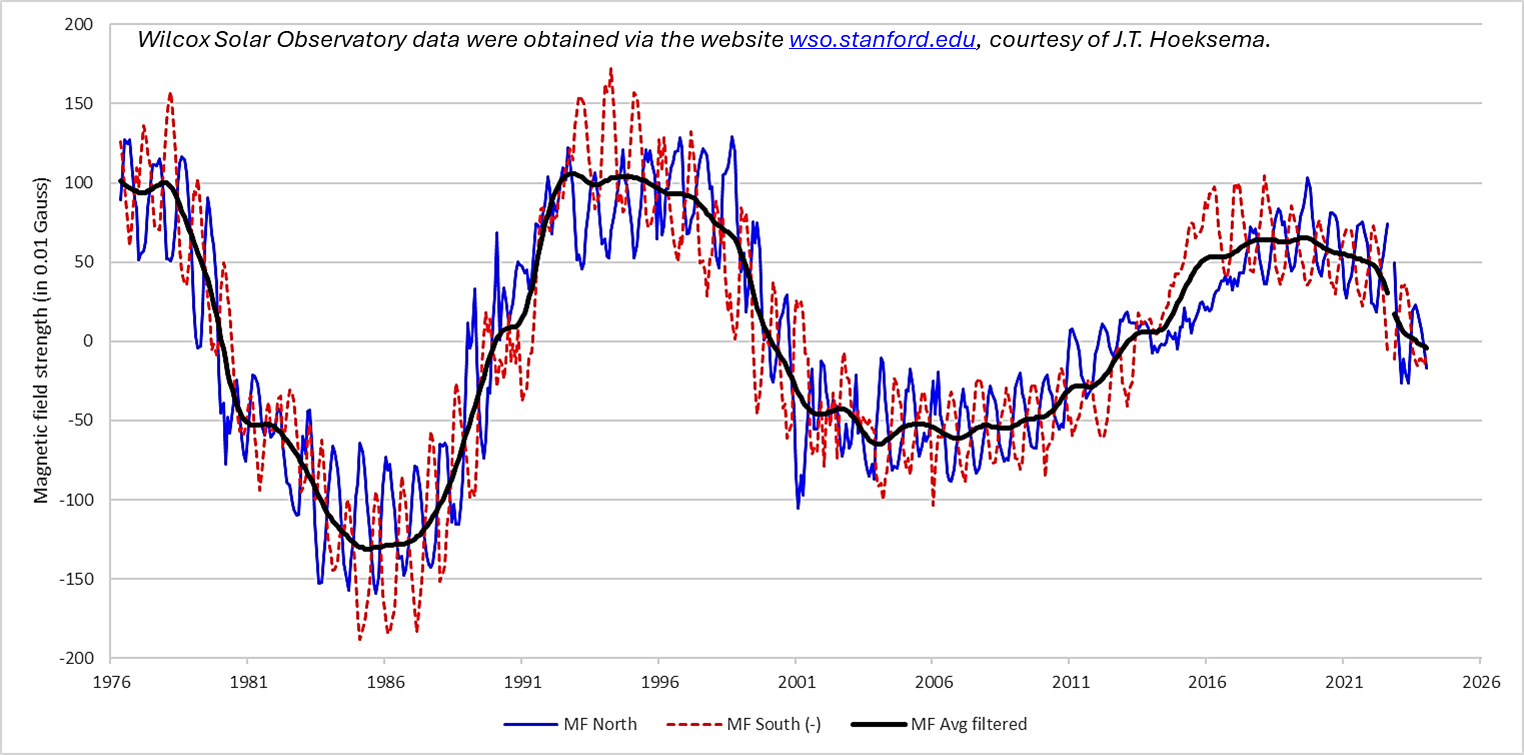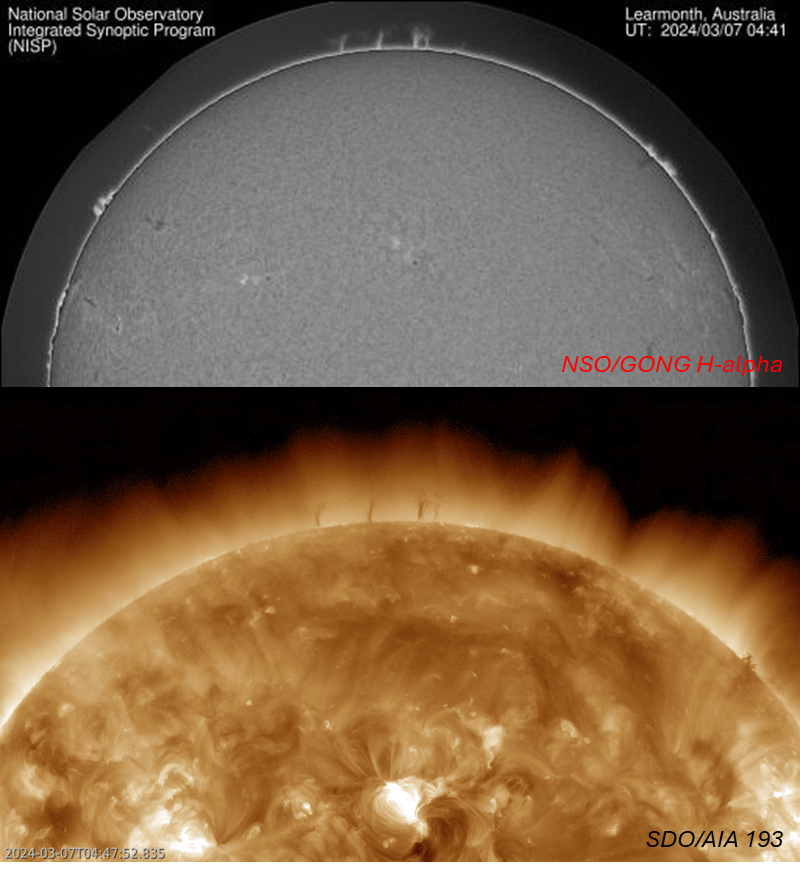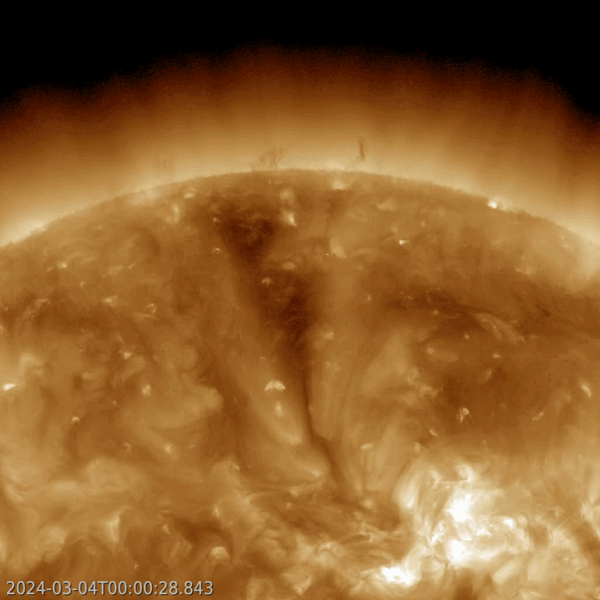Each solar cycle, during the period of maximum activity, the magnetic field at the solar poles disappears and gets replaced by a magnetic field of opposite polarity (see e.g. this STCE newsitem). These reversals are a key feature of the solar dynamo, and may take several months and longer before they are permanently established. Recent measurements by the Wilcox Solar Observatory (WSO - http://wso.stanford.edu/) of the Sun's polar magnetic fields confirm that this reversal is still ongoing, with the magnetic field strengths still close to zero Gauss, i.e. they are still alternating between positive and negative values at both poles.
In the graph underneath, polar magnetic field strength (WSO) is shown per month and per solar hemisphere (solid blue: north pole, dashed red: south pole) as well as the average value (thick black line). The magnetic field strength is expressed in units of 0.01 Gauss. The ups-and-downs in the curves for the north and south polar region are due to a seasonal effect: in the course of a year, as the Earth orbits the Sun, the instruments have a better look on the Sun's southern polar region during the January-April timeframe, and a better view on the northern polar region during the July-October period. The average magnetic field strength (black curve) has been filtered such that (most of) these ups-and-downs have been removed. The graph shows that the magnetic polarity for both polar regions has already been reversed briefly, but not permanently. Based on the available data points (last 4 solar cycles), the reversal at a single pole may take 1.5 years (median), with an uncertainty of one year. In view of the different evolution of the reversals at the different poles, and because of the long time a field reversal may take, it's no surprize that for several months around solar maximum, the Sun may exhibit two poles both with the same magnetic polarity. This creates very complex magnetic structures around the Sun, which in turn affect the rest of the solar system and helps for example to further reduce access of the cosmic rays to the earth environment - see the STCE's SC25 Tracking page.
When the filtered average magnetic field (black curve) reaches 0 Gauss, it usually takes another 6 months (median) before the smoothed monthly international sunspot number (ISN - SILSO) reaches its maximum, albeit with an uncertainty of again 12 months. The filtered average magnetic field strength switched sign in September 2023, but is currently still very near 0 Gauss. Taking into account the median delay of 6 months and the associated uncertainty, this confirms that a solar cycle maximum in 2024 is very likely.

That the polar field reversal is still ongoing is also clear from other observations. For example, the new polar coronal holes are still not firmly established. Though small and medium sized coronal holes with the new magnetic field polarity (North: positive, South: negative) are appearing at medium latitudes around 50 degrees, there's nothing substantial enough yet to build these new polar coronal holes. The presence of opposite magnetic field polarities near the poles is also clear from observations in H-alpha. Prominences at very high latitudes (80 degrees or more) could be observed last week near the Sun's north pole. Solar prominences are clouds of charged particles ("plasma") above the solar surface squeezed between magnetic regions of opposite polarity. Being cooler and denser than the plasma underneath and their surroundings, they appear as dark lines when seen on the solar disk (then they are called "filaments") and as bright blobs when seen near the solar limb. Special filters are required to observe these features, and can be obtained from the NSO/GONG network (https://gong.nso.edu/ ). These prominences were also observable in the much hotter extreme ultraviolet filters, where the "cold" features contrast as dark dynamic structures against the much brighter and hotter coronal background (SDO/AIA 193). Imagery in H-alpha and AIA 193 for the Sun's north pole can be found underneath.







